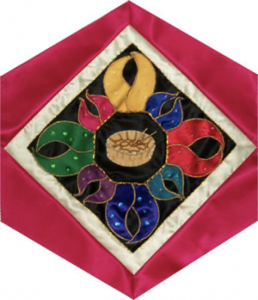Trinidad and Tobago

The Block
This dynamic tribute to Trinidad and Tobago’s world-famous Carnival was made by Badoora Rambaran. Celebrated annually on the two days before Ash Wednesday, this festival is a time for everyone to come together through music, song, dance and fanciful costumes to celebrate themselves, each other, freedom and life.
Satin, a popular fabric for the elaborately decorated costumes, is used to create colourful petals edged with metallic thread. They flow in an undulating pattern that brings to mind vibrant, swaying dancers. Shiny beads and sequins hand-stitched to each petal convey the glittery essence of the festivities. A steel drum, or pan, outlined in small silver beads, fills the centre of the block. Originating in Trinidad and Tobago, steel pans are created from used oil drums and provide the heartbeat of Carnival.
Cultural Profile
Trinidad, named after the Trinity Hills by Christopher Columbus, is a Caribbean island that resounds with the rhythmic beat of calypso music and the cadences of steel drum bands. The adjacent island, Tobago, meaning ‘island of flowers,’ is home to the bird-of-paradise flower brought there in 1912 for its protection. The official language of the islands is English although Hindi, French, Spanish and Chinese are also spoken, as well as Trinidian English Creole, which is in turn influenced by French Patois spoken around the Caribbean islands. Africans form the main ethnic group of Tobago; however Trinidad, the most cosmopolitan society in the Caribbean, has one of the world’s most multi-ethnic populations that includes East Indian, African, mixed European and Chinese.
Trinidad and Tobago enjoy the third highest GDP per capita in the Americas, after the United States and Canada, thanks to its large oil and gas reserves as well as a lively industrial sector. The islands also produce citrus and cocoa, and tourists visit the islands for their beautiful beaches and lively atmosphere.
The people of these islands have gained a reputation for enjoying life, having a great sense of vitality and creativity and communal life. Liming is part of this recreational life and involves passing time, being with friends and not doing anything too purposeful. Known for woodcarving, copper jewelry, woven straw items and boldly printed fabrics, the people of Trinidad and Tobago enjoy a rich cultural tradition in which music and dance play important roles.
The Carnival is the most important celebration of the year. It usually starts around December 26th with various Carnival fetes and culminates with jou’vert morning and the mas, the marching band parades of Monday and Shrove Tuesday. While jou’vert is the occasion for masquerade and street parties in the early hours of the morning, the mas are a display of lavish carnival costumes that take months to make. Traditional costumes have been well preserved in Trinidian Carnival, with characters such as devils, dragons, sailors, midnight robbers, gorillas or jab molassie (Molasses Devils).
Trinidadians and Tobagonians have been coming to Canada since 1946 with peaks years occurring from 1973 onwards. There are now approximately 68,000 Trinidadians in Canada, most living in the Toronto area. They have come here for education, professional advancement, job opportunities, family reunification and adventure, and have left a lasting influence on Canada, most noticeably through the introduction of calypso music and Carnival. Although Carnival, celebrated annually in Montréal and Toronto, has become a symbol of identity for the entire Canadian West Indian community, it is enthusiastically shared by many ethnic groups.
Sponsor National Council of Trinidad and Tobago Originations in Canada
